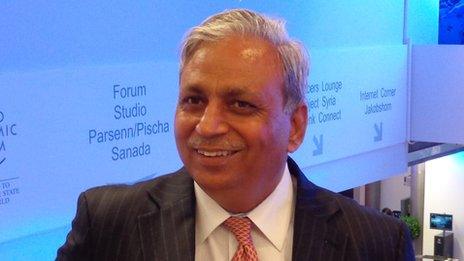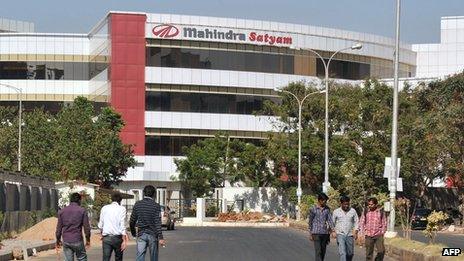From scandal to success: Turning around India's Enron
- Published

In January 2009, a corporate scandal emerged that became known as the Enron of India.
The chairman of Indian IT firm Satyam Computer Services admitted that its accounts had been falsified, in a case that echoed the collapse of US energy group Enron.
India's government stepped in and appointed a new board to try to sell the company.
It was bought by Indian conglomerate Mahindra Group, which renamed it Mahindra Satyam, and put Chander Prakash Gurnani in charge.
"Some of us had a firm belief that while the company's accounting books were toxic, the people were not," he says.
Faced with the challenge of rehabilitating the company, Mr Gurnani set about trying to convince everybody that it was still viable.
"I was on the road for 250 days in that year, being in front of every client and explaining," he says. "Frankly, all I did that year was talk, talk, talk, talk to the people and customers, day in, day out."
But at the same time he had to engage with regulators and prosecutors.
"There was a fraud committed, and there was a fraud investigation going on," says Mr Gurnani.
"We had to be able to answer everybody, and still maintain delivery excellence, still maintain investment into the future of the company."
Bruised morale
One of the urgent priorities when Mr Gurnani starting running Mahindra Satyam was to reduce the headcount from 53,000 people to about 35,000, to help return the company to profitability.
He and vice-chairman Vineet Nayyar agonised over how to go about doing this without damaging the already bruised morale in the company.

Mr Gurnani decided that departing staff would still get paid for six months
Mr Gurnani says he didn't want to hurt the affected staff, who would struggle to find new jobs in an Indian IT sector battered by the global recession.
Academic institutions and HR professionals all advised him the company should just pay off staff and get rid of them as quickly as possible. Mr Gurnani chose to ignore this advice.
He says: "We decided no, this is not their [the workers'] fault.
"They need to go back home and say they're still employed. The family does not want to bear the additional trauma of working in a company that has now been declared Enron, while the neighbour is asking, 'Was this the guy who was a fraud?'"
So instead of getting rid of staff overnight, Mr Gurnani decided that those affected would receive a small salary for six months and help in finding new employment.
"In those six months we had psychiatrists, we had a training department, we had job fairs, and we were doing all that to make sure that those people found a home," he says.
"Is this something that has been done before [in India]? No."
Mr Gurnani's next decision was that instead of trying to deal with all the company's problems in one go, he would break it up into 11 streams, which would be more manageable.
Proving sceptics wrong
Of his remaining staff, Mr Gurnani says: "Crises like this bring out the best in the people.
"If I have to salute one thing, it is the grit and the determination of the people, of my associates, who wanted to succeed, who wanted to prove the sceptics wrong.

Mahindra Satyam has since merged with Tech Mahindra
"I don't know whether I convinced them or they convinced themselves. I don't want to take any credit on this."
But he says that he had a simple formula for getting his message across to his still large number of staff.
"I believe in an equation, which says one guy can convince 10; 10 can convince 100; 100 can convince 1,000; 1,000 can convince 10,000. And trust me, I used that communication method to the hilt."
Mr Gurnani says he also valued working alongside vice-chairman Vineet Nayyar, a colleague for the past 20 years.
"He and I were joined at the hip to make things happen, and in many ways I think a pairing worked to our advantage.
"I was on-the-job training, and it's not that we don't make mistakes - we made mistakes - but having two people talk to each other 24/7 was a huge advantage."
The rehabilitation of Mahindra Satyam was completed in June last year, when the company merged with its sister company Tech Mahindra.
Mr Gurnani was put in charge of the combined group, which took the Tech Mahindra name.
He is now aiming to double the company's revenue by the end of 2015, through a combination of acquisitions and organic growth.
Five years on from a scandal that would have destroyed many companies, Mr Gurnani is now aiming for stellar growth.